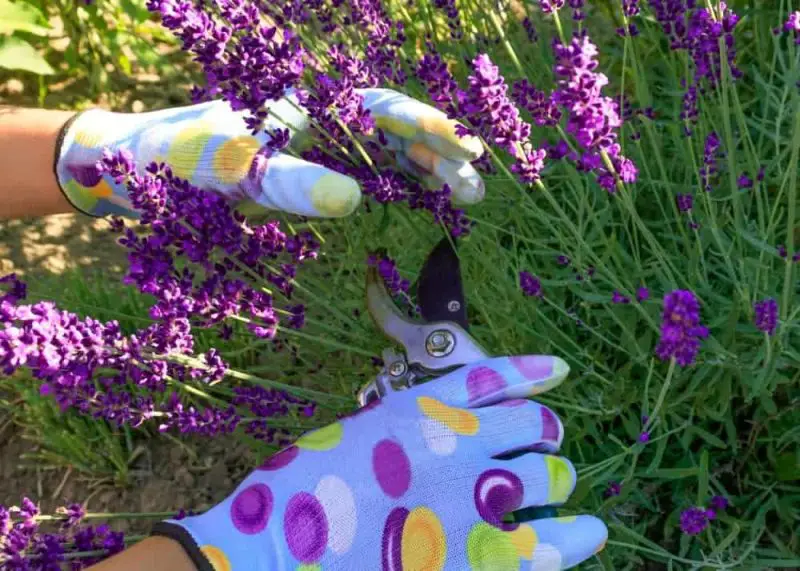Lavender, with its fragrant purple blooms and silvery-green foliage, is a beloved herb in gardens worldwide. Beyond its beauty and scent, lavender offers culinary, medicinal, and ornamental benefits. However, many gardeners wonder about the proper care techniques to keep this perennial plant thriving, especially concerning pruning practices. One common question is: Do you cut down lavender to keep it healthy? The answer is yes, but with some important considerations about timing, method, and purpose.
This comprehensive guide explores how cutting down lavender promotes its health and longevity, and what every gardener should know.
Understanding Lavender Growth and Health

Before delving into the specifics of cutting down lavender, it helps to understand how lavender grows and what it needs to stay healthy. Lavender is a woody perennial shrub native to the Mediterranean region, flourishing in well-drained, sunny locations. It typically develops a dense, bushy form with woody stems at the base and soft, leafy growth above. Its characteristic flowers appear on long spikes, usually blooming during the summer months.
Healthy lavender plants balance their woody base with new soft growth each season. Over time, however, if lavender is left unpruned, the plant may become woody and sparse in the center, leading to reduced vigor and fewer flowers. Cutting down or pruning lavender is an essential horticultural practice to rejuvenate the plant, encourage fresh growth, and maintain its attractive shape.
Why Do You Need to Cut Down Lavender?
The main reasons for cutting down lavender relate directly to plant health, appearance, and flowering potential. As lavender ages, the lower branches tend to harden into woody stems. These woody parts no longer produce new growth or flowers, which leads to a bare, leggy appearance. This can cause the plant to decline in vigor and reduce its ability to bloom abundantly.
Cutting down lavender also helps prevent the plant from becoming too large or misshapen. Regular pruning encourages compact growth, ensuring the plant remains dense and bushy. Moreover, trimming lavender after flowering removes spent blooms, which helps the plant conserve energy and focus on root and stem development rather than seed production.
In short, cutting down lavender is vital to:
-
Rejuvenate the plant by removing old, woody growth
-
Promote new soft shoots for better flowering
-
Maintain a neat, attractive shape
-
Prevent the plant from becoming too large or leggy
-
Improve air circulation within the plant to reduce disease risk
When Is the Best Time to Cut Down Lavender?
Timing plays a crucial role in successfully cutting down lavender without harming the plant. Generally, the ideal time to prune lavender is after it finishes flowering in late summer or early fall. At this stage, the plant has completed its blooming cycle, and trimming spent flower spikes prevents energy wastage on seed development.
Pruning too early, such as in spring, can remove tender new growth and reduce the number of flowers in the upcoming season. On the other hand, waiting too late in the fall or winter to cut down lavender may expose the plant to cold damage before it has a chance to recover.
Some gardeners also perform a lighter pruning in early spring to tidy up any winter damage and prepare the plant for new growth. However, the most significant “cutting down” or rejuvenation pruning should take place after the flowering period.
How Much Should You Cut Down Lavender?
One of the key considerations when cutting down lavender is how much of the plant to trim. Lavender has woody stems at the base that should generally be preserved, as cutting into these old wood areas can harm the plant and slow recovery.
Typically, gardeners cut back about one-third of the soft, leafy growth above the woody base. This means removing spent flower stalks and trimming the foliage lightly to encourage new shoots. If the plant has become very woody and leggy, a harder cut may be needed, but it should still avoid cutting into the main woody stems.
Cutting lavender too severely can cause the plant to struggle or fail to regrow. Conversely, pruning too lightly may not rejuvenate the plant sufficiently. Striking the right balance is essential to maintaining health and vigor.
Step-by-Step Guide to Cutting Down Lavender for Health
When cutting down lavender, the process should be deliberate and careful to maximize benefits. Begin by using clean, sharp pruning shears or garden scissors to prevent damaging stems or spreading disease. First, remove all spent flower spikes by cutting just above a set of leaves or lateral shoots. This helps the plant redirect energy to root and stem growth.
Next, trim back the leafy growth lightly, focusing on shaping the plant into a neat mound or dome shape. Avoid cutting into old, hard woody stems near the base unless absolutely necessary. For older plants that have become leggy, a more substantial cut may be performed, but care should be taken to leave some green growth to support recovery.
After pruning, it is helpful to remove any debris around the plant base to reduce fungal or pest issues. Water the plant moderately and avoid overwatering, as lavender prefers dry, well-drained conditions.
Common Mistakes to Avoid When Cutting Down Lavender
Many gardeners unintentionally harm their lavender plants by making common pruning mistakes. One frequent error is cutting into the woody base too deeply. Lavender’s woody stems often do not produce new growth once hardened, so removing them can leave the plant vulnerable and stunted.
Another mistake is pruning at the wrong time. Cutting lavender in late fall or winter can expose the plant to cold damage, as it won’t have enough time to recover. Similarly, pruning too early in spring can remove new growth and reduce flowering.
Some also prune lavender too aggressively, cutting back more than half the plant, which stresses the shrub and delays recovery. Others fail to prune at all, resulting in a leggy, unproductive plant with fewer flowers.
To keep lavender healthy, pruning should be moderate, timely, and focused on encouraging new soft growth without damaging the woody structure.
How Cutting Down Lavender Affects Flowering
Cutting down lavender directly influences its flowering potential. By trimming spent blooms and shaping the plant, you encourage the development of new shoots that will produce flowers in the next growing season. Proper pruning increases air circulation and sunlight penetration within the plant, both of which are vital for robust flowering.
If lavender is left uncut, old woody stems dominate, and flower production decreases. Pruning stimulates the plant’s natural growth hormones, promoting vibrant, dense blooms. However, cutting too late or too severely can reduce flowering in the following season by removing too much growth.
Therefore, regular and well-timed cutting down of lavender ensures a consistent and abundant display of flowers year after year.
Lavender Pruning Techniques for Different Varieties
Different types of lavender may require slightly different pruning approaches based on their growth habits. English lavender (Lavandula angustifolia), which is the most common garden variety, responds well to moderate pruning after flowering, encouraging bushy growth and dense flower spikes.
French lavender (Lavandula dentata) and Spanish lavender (Lavandula stoechas) typically have softer woody stems and may benefit from lighter pruning throughout the year to maintain shape. These varieties can be more sensitive to heavy cutting and may not recover as quickly from severe pruning.
Understanding the specific variety of lavender you grow helps tailor your cutting practices for optimal health and appearance.
Caring for Lavender After Cutting Down
Once you have cut down lavender, proper aftercare helps the plant recover quickly and remain healthy. Since lavender thrives in well-drained, sunny spots, ensure the plant receives at least six hours of direct sunlight daily. Avoid overwatering, as lavender is drought-tolerant and prone to root rot if soil stays too wet.
Fertilizing lavender after pruning is generally unnecessary, as the plant prefers lean soil. However, a light application of balanced fertilizer or compost in early spring can support new growth. Mulching around the base with gravel or small stones can improve drainage and reduce weed competition.
Monitoring the plant for pests such as aphids or fungal diseases is important, especially after pruning when new growth is tender. Prompt treatment helps maintain vigor and flowering capacity.
Alternative Pruning Methods: Shearing vs. Hard Cutting
Besides the typical cutting down after flowering, gardeners sometimes debate between light shearing and hard cutting methods. Shearing involves trimming the top growth lightly to shape the plant without removing large amounts of foliage. This technique maintains a tidy appearance but may not sufficiently rejuvenate older lavender.
Hard cutting involves cutting back lavender severely, sometimes by half or more, to stimulate fresh growth. While this method can revitalize woody, overgrown plants, it carries more risk. Cutting too deeply into old wood may cause dieback or plant decline.
Choosing the right method depends on the age and condition of the lavender. Younger plants often benefit from regular light pruning, while older shrubs may require occasional hard cuts but with caution.
The Role of Seasonal Changes in Lavender Pruning
Seasonal timing affects how well lavender responds to cutting down. Late summer and early fall pruning align with the plant’s natural cycle of flowering and dormancy preparation. This timing allows lavender to heal and produce new shoots before winter.
Winter pruning is usually discouraged because cold temperatures slow healing and increase vulnerability. Spring pruning can be useful for tidying winter damage but should be light to avoid removing new growth.
Understanding how lavender’s growth cycle interacts with seasons helps gardeners plan pruning schedules that optimize plant health and flowering.
How Long Does It Take Lavender to Recover After Cutting?
Recovery time after cutting down lavender varies based on the pruning severity, plant age, and environmental conditions. Typically, lavender starts producing new shoots within a few weeks of moderate pruning during the growing season. Flowering may resume the next summer if pruning was done correctly.
Hard-cut lavender or older, woody plants may take longer to recover, sometimes several months or even a full growing season. Providing ideal conditions, such as adequate sunlight, well-drained soil, and moderate watering, accelerates recovery.
Patience is key when cutting down lavender, as the plant prioritizes establishing new healthy growth before flowering again.
Signs Your Lavender Needs Cutting Down
Knowing when lavender needs cutting down is essential for ongoing health. Some signs include a plant that looks leggy, with bare woody stems at the base and sparse foliage above. Reduced or absent flowering can also indicate the need for pruning.
If lavender appears overgrown or misshapen, it likely benefits from trimming to restore its compact form. Similarly, if the plant produces weak or small flower spikes, cutting down spent blooms and shaping the plant can boost vigor.
Regular observation helps gardeners identify when lavender requires attention to maintain its best condition.
FAQ about Do You Cut Down Lavender
Do you need to cut down lavender every year?
Yes, cutting down lavender annually after it blooms helps keep the plant healthy, encourages new growth, and promotes abundant flowers.
When is the best time to cut down lavender?
The best time to cut down lavender is right after the flowering period, typically in late summer or early fall, to allow the plant to recover before winter.
Can you cut lavender too short?
Yes, cutting lavender too short or into the woody base can damage the plant and slow down its recovery. It’s best to trim about one-third of the soft growth above the woody stems.
What happens if you don’t cut down lavender?
If lavender is not cut down regularly, it may become woody and leggy, producing fewer flowers and losing its attractive shape.
How do you care for lavender after cutting it down?
After pruning, ensure lavender gets plenty of sunlight, avoid overwatering, and maintain well-drained soil to support healthy new growth.
Conclusion: Cutting Down Lavender Is Essential for Its Health
In summary, cutting down lavender is a crucial gardening practice that promotes plant health, rejuvenates growth, and maximizes flowering potential. Done at the right time, with proper technique, and avoiding common mistakes, pruning lavender keeps this fragrant herb thriving for years.
Whether you have English, French, or Spanish lavender, regular trimming after flowering maintains a dense, attractive shape and prevents the plant from becoming woody and leggy. After pruning, proper care, including adequate sunlight and well-drained soil, supports quick recovery.
By understanding the why, when, and how of cutting down lavender, gardeners can enjoy vibrant blooms and healthy plants season after season.






